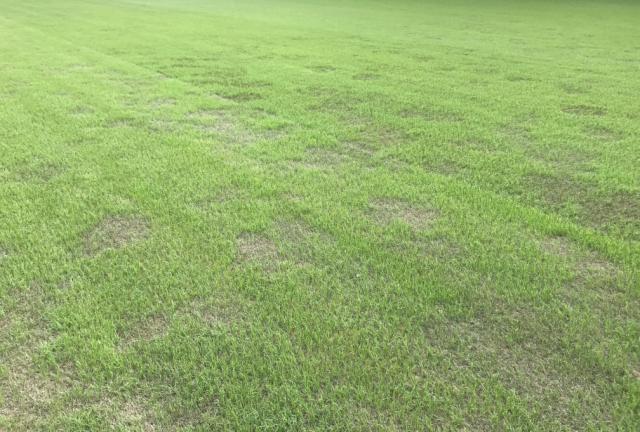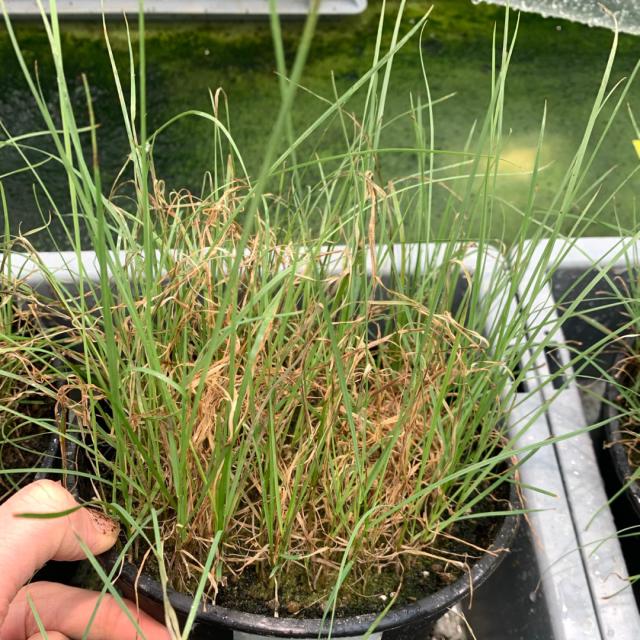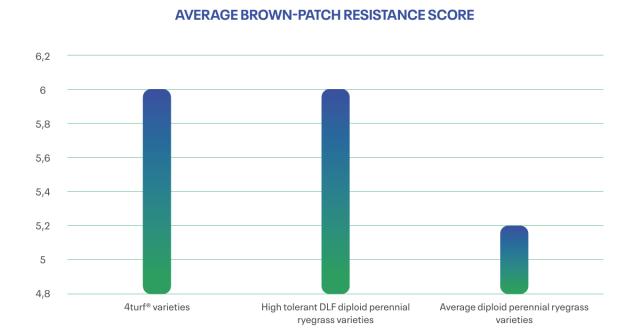
Brown Patch resistant turf
As climate change brings hotter and humid weather, the severity and geographic range of fungal diseases are increasing. Disease control has become a greater challenge for many turf managers as they seek to reduce pesticide use. 4turf® tetraploid perennial ryegrass varieties have proven to be highly resistant to brown patch, as have several other outstanding diploid varieties from DLF. The use of 4turf®, and certain diploid varieties gives you a better brown patch resistance. Choosing varieties with high brown-patch resistance reduces your reliance on fungicides, and gives you a better pitch quality, more playing hours and increased peace of mind.
What is Brown Patch?
Brown patch is a turfgrass foliar disease caused by Rhizoctonia spp. The fungus can attack all cool season turfgrasses, but is most devastating to perennial ryegrass, bentgrass and tall fescue. Attacks are triggered by hot, humid conditions, especially if the grass has been overstimulated with nitrogen fertiliser.
In the early stages symptoms can be easy to overlook. The affected turfgrass may show small, circular areas of light brown or yellowing grass. A key early sign is the presence of a thin, dark, smoke-colored ring around the edges of these patches, which may be most visible in the morning when dew is present. Individual leaves may Average disease resistance develop irregular tan lesions with darker brown borders, although this can be hard to spot without close inspection. As the disease progresses, the patches expand and coalesce, sometimes forming large, irregular areas of damaged turf. The centers of older patches may recover, giving the disease a characteristic “frog-eye” appearance with a ring of dead or dying grass surrounding a core of healthy turf. Affected areas often appear thinned out or sunken compared to the surrounding healthy grass. In more advanced stages, large sections of turf may collapse entirely, especially in humid, warm weather conditions that favor rapid fungal growth.
Unique screening method
DLF has developed a unique greenhouse screening method to identify the most brown-patch-resistant perennial ryegrass varieties. The screening procedure was developed in collaboration with rhizoctonia experts at a sugar beet breeding station. The screening was done with three different fungal isolates from European football pitches.

High disease resistance
Average disease resistance
Low disease resistance
Brown Patch problems
Brown patch is becoming more common in high-end stadiums and training grounds across Northern Europe due to changes in the climate that favors the disease. The disease can potentially lead to the loss of an entire pitch if it attacks young seedlings during establishment or renovation. During hot, moist summers brown patch can also occur at a later stage of growth where it causes severe damage and dramatic reductions in pitch quality.
Screening results
The results of the screening show significant differences in levels of brown-patch resistance between perennial ryegrass varieties. 4turf® varieties are significantly more resistant to brown patch than most diploid perennial ryegrass but we have also identified specific diploid perennial ryegrass varieties with high resistance.
